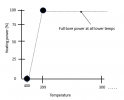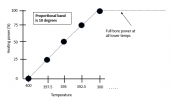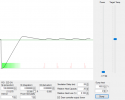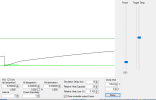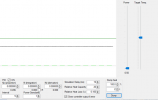Cushing H.
Gold Member
- Joined
- Jun 3, 2019
- Messages
- 2,714
It seems like there are a few folks out there that end up getting confused with their PID controllers, even when using "Autotune" - so the attempt here will be to supply enough information for people to take a "not-behaving" PID system and get it working. Or ... to understand why it is not working, and what to do to correct it.
I will need a little time to pull this together, but in this initial post, I will try to make a few points, that hopefully I will substantiate in the later specific posts.
The first point I would like to make is that a PID controller is not a cure-all for any system it is attached to. The reason for this is that, the combination of the controller, and the widget (mahchine, oven, forge, whatever) it controls for a complete system. Change one or either of them (machine or controller) and the overall behavior of the system will change. A controller "tuned" at 2000F will not well control an oven at 400F (someone recently saw this). A PID controlled forge working well inside a workshop might well not control its temperature well when moved outside where the wind both cools the outside of the forge, and blows air through it, changing how and how fast heat escapes the inside of the forge (recently WEO experienced this).
Another point is that any system that a PID controller is managing must be reasonably balanced. By that I mean (sticking with the theme of controlling ovens) that the overall rate of heat input (at 100% of possible input), must be fairly close in magnitude to the rate at which heat escapes from the oven through its insulation. (for example, a nearly "perfectly" insulated oven can not be controlled by a PID, and likewise, a very poorly insulated oven will also have problems trying to control it with a PID) (again, I think some others have recently seen this when trying to get a toaster oven to work with a PID ... and did not succeed until adding more insulation to it)
the final point is that in using a PID controller, you pretty much need to decide on whether you want fast responses and corrections to changes in temperature, or whether you want accurate control with very little variation around a target temperature. It is not always the case ... but for the most part there is still a trade-off between these two objectives.
For the most part, I will try to use diagrams and plots to make the points .... but I do need to introduce some math - because that ties directly into the language in the user manuals and thus how you know how to configure the things. I will keep it light though, and simplify pretty significantly.
And yes, the Inkbird manual is awful. It actually, as far as I can tell, reverses the meaning of at least one parameter. Again, I will work to clarify as I go....
I will need a little time to pull this together, but in this initial post, I will try to make a few points, that hopefully I will substantiate in the later specific posts.
The first point I would like to make is that a PID controller is not a cure-all for any system it is attached to. The reason for this is that, the combination of the controller, and the widget (mahchine, oven, forge, whatever) it controls for a complete system. Change one or either of them (machine or controller) and the overall behavior of the system will change. A controller "tuned" at 2000F will not well control an oven at 400F (someone recently saw this). A PID controlled forge working well inside a workshop might well not control its temperature well when moved outside where the wind both cools the outside of the forge, and blows air through it, changing how and how fast heat escapes the inside of the forge (recently WEO experienced this).
Another point is that any system that a PID controller is managing must be reasonably balanced. By that I mean (sticking with the theme of controlling ovens) that the overall rate of heat input (at 100% of possible input), must be fairly close in magnitude to the rate at which heat escapes from the oven through its insulation. (for example, a nearly "perfectly" insulated oven can not be controlled by a PID, and likewise, a very poorly insulated oven will also have problems trying to control it with a PID) (again, I think some others have recently seen this when trying to get a toaster oven to work with a PID ... and did not succeed until adding more insulation to it)
the final point is that in using a PID controller, you pretty much need to decide on whether you want fast responses and corrections to changes in temperature, or whether you want accurate control with very little variation around a target temperature. It is not always the case ... but for the most part there is still a trade-off between these two objectives.
For the most part, I will try to use diagrams and plots to make the points .... but I do need to introduce some math - because that ties directly into the language in the user manuals and thus how you know how to configure the things. I will keep it light though, and simplify pretty significantly.
And yes, the Inkbird manual is awful. It actually, as far as I can tell, reverses the meaning of at least one parameter. Again, I will work to clarify as I go....




